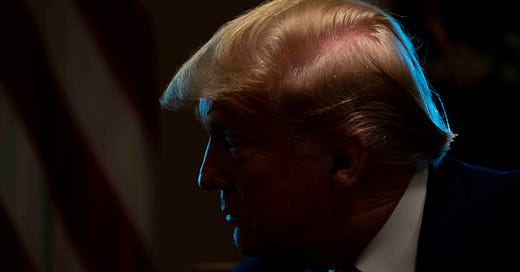LAST WEEK, AFTER MONTHS of hints and innuendo, we finally got some insight into former President Donald Trump’s plans for Ukraine should he return to the White House. While the details remain scarce, the Washington Post revealed that Trump’s Ukraine policy will center on “pushing Ukraine to cede Crimea and the Donbas border region to Russia.” The plan is a “terrible deal,” as Emma Ashford of the Stimson Center told the Post. But it’s worth delineating precisely why Trump’s anticipated Ukraine policy is so appalling—and what an affront it is to both Ukrainian and American interests.
Trump’s position apparently stems from his belief that Russia is simply looking for a negotiated exit from the war in Ukraine. Such a framing not only echoes other Trump supporters—such as Ohio Sen. J.D. Vance, who last week repeated calls for “negotiations” in the New York Times—but it further smacks of the Obama administration’s myopic beliefs that it could find an “off-ramp” for Moscow following Russia’s initial 2014 invasion. As Trump sees it, Russia wants “to save face, they want a way out,” per the Post’s reporting.
Would that it were so. There were many off-ramps on the road to Kyiv, and Putin took none of them. As Putin has revealed over and over again, his designs are hardly limited to a territorial land-grab in southern and eastern Ukraine.
At the outset of the full-scale invasion in 2022, Putin’s rhetoric was (as it still is) saturated in calls to “denazify” Ukraine. In the ensuing two years, we’ve learned how Putin intended on toppling Ukraine’s government wholesale, even going so far as to send assassination squads after Ukrainian president Volodomyr Zelensky and drafting plans to return Viktor Yanukovych, whom Ukrainians ran out of power in 2014, to leadership. Putin’s overall plan was to geld Ukraine, to return Kyiv to the Kremlin’s subservience, and to restore Moscow’s imperial writ across the country. Along the way, he hoped not only to push Russian sovereignty all the way to the Moldovan enclave of Transnistria, but, as he demanded at the outset of the 2022 invasion, a removal of NATO troops from all of Eastern and much of Central Europe.
Two years into the expanded invasion, it’s easy to forget these details, especially with the war bogged down in Ukraine’s east. But it’s worth remembering, especially as Russia girds for a renewed summer offensive, that contra Ron DeSantis, this war is no mere “territorial dispute.” It is an effort to reverse the outcome of the Cold War, to divide Europe into empires and batter it with revanche. This is, in many ways, a story Europe has seen before, from Hitler’s Germany to Milosevic’s Serbia.
Trump’s proposals completely ignore the previous, hard-won lessons that offering territory to dictators on the march will hardly satisfy them. Indeed, Trump appears unaware that Putin has claims to have “annexed” regions beyond what his army now controls—territories Putin will, of course, continue pushing for, slaughtering as many Ukrainians as needed in the process.
Nor is it just that Trump’s proposals amount to little more than warmed-over appeasement. As he’s done for years, Trump has completely misunderstood the local dynamics and desires of the Ukrainians in Crimea and the Donbas. For years, Russian nationalists have claimed Moscow’s rightful ownership of Crimea, crowing that the peninsula is an historic font of Russian identity, and that Moscow’s 1954 transfer of the peninsula to Soviet Ukraine was an historic blunder. What those nationalists ignore, however, is not only that Russians were hardly an ancient or dominating force on the peninsula—it wasn’t until World War II that Russians were the ethnic majority in Crimea, and only then as a result of Joseph Stalin’s massive ethnic cleansing campaigns—but that Crimeans have never evinced any clear desire to be ruled from Moscow. The majority of Crimeans voted for Ukrainian independence from the Soviet Union in 1991, just like every other Ukrainian province. In polling leading up to the Russian invasion in 2014, less than a quarter of Crimeans claimed any desire for Russian annexation.
Little wonder, then, that Moscow’s 2014 annexation relied on a ballot-by-bayonet referendum, the results of which—with a supposed 97 percent of Crimeans suddenly voting for Russian annexation—are about as credible as Putin’s recent presidential victory. Even anecdotally, the clear lack of desire among Crimeans to join Russia’s embrace was palpable. When I toured the peninsula just a few months before Ukraine’s 2013–14 revolution, pro-annexation sentiment in Crimea was effectively nonexistent. In Yalta, locals were far more interested in strolling the promenade, scaling the rocky outcroppings, and boozing on the beach. In Bakhchysarai, the Crimean Tatars I spoke with, including those ethnically cleansed by Stalin during WWII and their descendants, were all far more interested in restoring their own histories and legacies on the peninsula, rehabbing the local Khan’s Palace, and opening a spate of new Tatar restaurants than joining Russia.
In Simferopol, Crimea’s capital, scattered Russian flags may have fluttered, but there was no chatter of annexation whatsoever. Such a dearth of pro-Kremlin sentiment echoed the observations of the Russians who spearheaded Moscow’s 2014 intervention. Igor Girkin, the Russian national (and war criminal) who helped lead Russia’s invasion, later revealed he “didn’t see any support [for annexation] from any organ of government power” in Crimea. As other journalists noted, rather than witness an upswell of pro-Russian sentiment, Russian special forces swarming Simferopol were instead forced to wrangle Crimean deputies into a quorum to vote for annexation.
Trump, though, couldn’t care less about these realities. To him, and to all those others who’ve swallowed Putin’s claims to the peninsula, Crimeans “would rather be with Russia than” Ukraine, as Trump sputtered in 2016. Rather than Ukrainians waiting for liberation, Trump would have those still on the peninsula, as well as across Eastern Ukraine, permanently consigned to Russian rule—to oppression by a dictator wanted by the International Criminal Court, and to a country whose imperialist designs have “no borders.”
Trump’s proposals, if followed through, would simply whet Putin’s irredentism and allow him time to rearm for yet another effort to subdue Ukraine. Not only would Europe be that much more destabilized and America’s national security interests that much more threatened, but revanchists from Beijing to Caracas would grow that much more confident. Thanks to Trump, the world would be once more safe for empire.
Of course, at that point, Trump may not care, as drenched as he and his followers are in anti-Ukrainian conspiracies. And at that point, Putin may not be the only one happy to see Ukraine demolished as a sovereign entity—regardless of the cost to American interests, or to the Ukrainians whom Trump would force into Russia’s permanent embrace.






